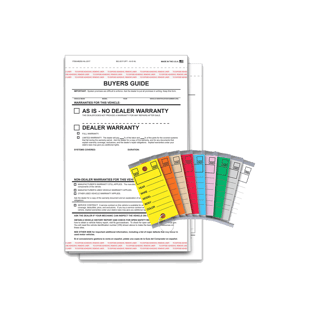
Menu? We Don’t Need No Stinkin’ Menu! (Yes, Yes You Do)
August 2020
Eric L. Johnson
As you know, the pandemic shelter at home orders forced the closing of dealerships across the country. I suspect that the shutdowns and the new ways dealers have developed to continue to move the metal have inspired some dealers to evaluate their menu selling process when presenting voluntary protection products (VPPs) to customers. I can certainly attest that I’ve been getting more inquiries about menu selling from dealers and thought I’d briefly summarize the standards a dealer should adopt before presenting VPPs to customers and beneficial content for a menu.
As a starting point, you should know that there is no federal law that specifically requires dealers to show in a menu the full cost of a VPP product. Still though, the Federal Trade Commission and the Consumer Financial Protection Bureau have shown significant interest in how things are disclosed to consumers. And, the FTC and the CFPB have authority under federal law to determine when a practice is unfair or deceptive (and, in the CFPB's case, abusive). So, is it unfair, deceptive, or abusive to not disclose to a customer the actual cost of a product being purchased? Given the federal regulators preference towards transparency and full disclosure, dealers should carefully consider their menu selling standards and practices to meet or exceed federal regulators’ expectations.
What are some of the standards that a dealer should adopt before and when presenting a VPP product to its customers? Well, for one, a dealer should present VPPs in a manner that will help the customer make an informed purchasing decision about the product(s). This includes presenting to the customer information about the VPPs’ benefits, cancellation and refund rights and procedures; the claims process; deductibles, if any, for the product; eligibility for the product; limitations on the product; price; requirements for maintaining coverage; and other important terms and conditions of the product.
A dealer should also ensure that its employees who offer VPPs understand their benefits, limitations, and other terms and conditions before offering them to customers. How can an employee offer and speak intelligently about a VPP product if they don’t know these things? A dealer should not offer a VPP to a customer for which they are ineligible or that provides no value to the customer. The “no value” standard can be a bit tricky to determine, but know the regulators take a very dim view of products that provide no value to the customer.
A dealer should also set objective policies for any markup practices on VPPs. Further, a dealer should offer every customer the opportunity to buy or decline every VPP the dealer sells (for which the customer is eligible) in connection with the vehicle sale and document that offering in writing. Any sales script and menu used by the dealer should be reviewed by knowledgeable counsel prior to their use.
I’m often asked if it’s possible to develop a menu checklist to be used to compare a dealer’s menu against standard menu practices. If I were to develop such a checklist, here are the sorts of things that I would expect to see on a good menu selling document. The standard menu format should be simple and, at a minimum, prominently disclose that the purchase of any listed VPP is optional; that any listed VPP may be purchased separately (if true); that the purchase of any listed VPP is not required as a condition to purchase or lease a vehicle or to qualify for financing, obtain warranty coverage, or receive financing on particular terms; that the listed VPPs or the protections they provide may be available from other sources (if true); that the dealer may retain a portion of the sale price of the listed VPPs (if true); the price of—and monthly payment for—the vehicle with and without the purchase of a VPP or service selected by the customer; the price of—and monthly payment for—each VPP if purchased separately; and the price of—and monthly payment for—each product bundle if VPPs are purchased as a bundle (e.g., the “Platinum Package”).
What about the practice of actually offering the VPPs to a customer? Prior to the sale of a VPP, a dealer should provide the customer with a copy of, and an opportunity to review, each selected VPP’s terms and conditions as well as any other required disclosures. In addition, a dealer should get the customer’s acknowledgement of the menu disclosures and his/her election to either purchase or decline each selected VPP or VPP bundle.
Ok, so now you have a smooth process for offering the VPP to a customer and a transparent menu. What should a dealer do post-sale? Don’t forget to provide your customer with any required post-sale forms of the selected VPP. And, a good operator will ensure that its menu and menu selling process are audited every so often to ensure its employees are using the approved script and menus in the way they are supposed to be used.
Regardless of whether your showroom is open or closed to the public, to combat a claim of unfair, deceptive or abusive practice, you need standards, an approved and vetted script and menu selling document when offering VPPs to your customers.
PARTNER SPOTLIGHT
Dealer Management System, Computer Technology, Media/Advertising, Automotive Auction, F & I/Aftermarket Products, Automotive Technology Training & Compliance
 A NHADA Gold PARTNER
A NHADA Gold PARTNERComputer Technology, Automotive Shop Equipment, Environmental Services
 A NHADA Platinum PARTNER
A NHADA Platinum PARTNERF & I/Aftermarket Products, Automotive Technology Training & Compliance, Environmental Services
.png?width=150&name=corp_logo_horz_on_light_with_trademark_symbol_1200w%20(002).png) A NHADA Diamond PARTNER
A NHADA Diamond PARTNERF & I/Aftermarket Products, Financial Services, Automotive Technology Training & Compliance
 A NHADA Diamond PARTNER
A NHADA Diamond PARTNER
Eric L. Johnson is a partner in the Oklahoma City, OK office of Hudson Cook, LLP. Eric can be reached at 405.602.3812 or ejohnson@hudco.com. This article is provided for informational purposes and is not intended nor should it be taken as legal advice. ©Copyright 2020 Eric Johnson. All rights reserved.



















.png?width=150&name=Ally_Final%20Logos%20and%20Pairings_11.14.2018-01%20(2).png)


-2.png?width=150&name=Wipfli%20Logo%20Blue%20RGB%20(1)-2.png)


.jpg?width=150&name=NHADA_Partner_FTR_Img_NHADA_Insurance%20(1).jpg)


.jpg?width=150&name=NHADA_Partner_FTR_Img_JMA(1).jpg)






